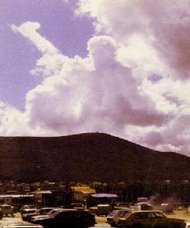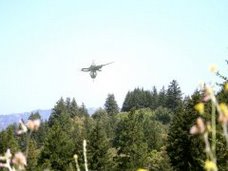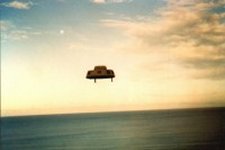A longstanding interest of scientists has been migration of animals and birds, i.e. movements of animals and birds in large numbers from one place to another. In modern usage the term is usually restricted to regular, periodic movements of populations away from and back to their place of origin. A single round trip may take the entire lifetime of an individual, as with the Pacific Salmon; or an individual may make the same trip repeatedly, as with many of the migratory birds and mammals. The animals may travel in groups along well-defined routes; or individuals may travel separately, congregating for breeding and then spreading out over a wide feeding area, as do some of the seals.
Seasonal migrations occur in many species of insects, birds, marine mammals, and large herbivorous mammals. These migrations often provide the animals with more favorable conditions of temperature, food, or water. Many birds and a few bats of cold and temperate regions migrate to warmer areas during the winter. Herbivores of cold regions, such as wapiti (elk), caribou, and moose, have summer and winter ranges; many herbivores of warm regions, such as the African antelopes, migrate seasonally to avoid drought. These migrations may involve a change of latitude, of altitude, or both.
In many cases the chief function of seasonal migration is to provide a suitable place for reproduction, which may not be the place most suitable for the feeding and other daily activities of adults. Hundreds of thousands of gnus (wildebeests) of E Africa take part in annual migrations to calving grounds. Many fishes migrate to spawning grounds, and in some cases this involves a change from saltwater to freshwater (e.g., salmon) or vice versa (e.g., freshwater eels). Sea turtles, seals, and many sea birds come ashore to breed, and most amphibians gather near water at the breeding season. Fur seals and many whales make ocean voyages of thousands of miles to their breeding grounds, the former coming ashore on islands. Such migration is seriously affected by the increasing rate of destruction of natural habitats.
Much work has been done on orientation and navigation in migrating animals, although the subject is still not well understood. Studies of salmon indicate that they depend on the olfactory sense to locate and return to their stream of origin. Herbivorous mammals often follow well-established trails and probably also use their sense of smell. Bats, whales, and seals use echolocation to navigate in the dark or underwater; in addition, some whales appear to take visual bearings on objects on the shore in their migrations.
Migratory birds are believed to use the stars, sun, and geographic features as guides. The probability that stellar navigation is used has been strengthened by experiments in planetariums indicating that birds navigate at least in part by the stars. Night-migrating birds are sometimes disoriented in prolonged heavy fog. Day-flying birds navigate by the sun and also make some use of geographic features, particularly of shorelines. It has long been proposed that birds perceive the direction of the earth's magnetic field and use it for navigation, but experimental evidence for that hypothesis is inconclusive. Most migratory birds travel within broad north-south air routes known as flyways. There are four major flyways in North America, called the Pacific, central, Mississippi, and Atlantic flyways. The space within the flyway used by a particular group of birds is called a corridor. Bird migration is not always in a north-south direction. Many European birds migrate in an east-west direction, wintering in the more temperate British Isles, and many mountain-dwelling birds descend to lower altitudes in winter. The breeding grounds of a bird species are regarded as its home territory. Some migratory birds winter only a few hundred miles from their breeding grounds, while others migrate between the cold or temperate zones of the two hemispheres. The longest journey is made by the arctic tern, which alternates between the Arctic and the Antarctic.
The monarch butterfly has a north-south migration pattern that resembles that of many birds. One monarch population that inhabits northeastern and midwestern North America averages c.12 mph (19 kph) as it heads for the winter to Mexico's Sierra Madre mountains. Monarchs start the return trip in the spring, but they breed along the way and then die; the new generation completes the journey.
skip to main |
skip to sidebar




--------------------------------------------------

--------------------------------------------------


-------------------------------------------------

2007 - Tatui-Sao Paulo, Brazil

2007 - Big Basin, California

2004 - Long Island, New York

2001 - Foster City, California

1995 - Kazakhstan, Russia

1993 - Ochre Point, Southern Australia

1992 - Pueblo, Mexico

1989 - Nashville, Tennessee

1982 - Switzerland
# MASKED PRISONER # DINOSAURS # RIPPER # ALIENS # HUMAN COMBUSTION # GIANT LIZARD # BURIAL PLACE OF GHENGIS # PHILOSOPHER'S STONE # REINCARNATION # POLTERGEIST # HAUNTED CASTLES # MIGRATION # KING ARTHUR # DEATH WORM # BERMUDA TRIANGLE # DEVIL # GHOSTS # DRAGONS # YETI # UFOS # NOSTRADAMUS # LEVITATION # NOAH'S ARK # DRAGON'S TRIANGLE # SASQUATCH # GHOST OF BREGAVY # GIANT CHIMPS # "NTIKYTHERA # STONEHENGE # ATLANTIS # MONSTER OF THE AMAZON # PHANTOM # GHOSTS # MONSTERS
Facebook Badge
Labels
- 'THE NATIONAL' ABU DHABI AND 'THE TRIBUNE' NORTH INDIA (1)
- "CITY AUTHOR PENS RECORD" - SHARING THE NEWS ITEM WHICH WAS PUBLISHED IN YESTERDAY'S 'DAINIK JAGRAN' NEWSPAPER ('CITY PLUS' SUPPLEMENT) (1)
- 2013 (1)
- 2015 (2)
- A Link between Egypt and Americas? (1)
- a record book published by Coca Cola India (1)
- Aliens love oceans (1)
- An article about my five books...published in eight months... (1)
- An Excerpt From My Book: "A Matter Of Survival" (1)
- and first political crime thriller) (1)
- Another newspaper story about my career as an author (1)
- Article about me: "Writing a new chapter at 50 plus"... (1)
- Article about my books and me in the national daily The Hindustan Times (1)
- ARTICLE ABOUT MY FIVE BOOKS IN THE TIMES OF INDIA (1)
- ARTICLES ABOUT MY BOOKS IN 'GULF NEWS' DUBAI (1)
- as author with most books on crime fiction in shortest time (1)
- AT THE TIMES GROUP BOOKS STALL...DELHI WORLD BOOK FAIR 2013...WITH TWO OF MY BOOKS (1)
- Atlantis - The Lost Continent (1)
- caught on camera (1)
- Cleopatra died of drug-spiked cocktail (1)
- Colorado (1)
- Did Napoleon die from poisoning? (1)
- Dragons - Myth Or Reality? (1)
- Easter Island's Walking Stones (1)
- Eight book reviews of my new novel "Chief Minister's Mistress"..... (1)
- Extinction of dinosaurs (1)
- Famous American Ghosts... (1)
- Featuring for two consecutive years in the Limca Book of Records (2012 and 2013) (1)
- Ghosts (1)
- Giant Chimps Of The Magic Forest (1)
- Haunted Scottish Castles (1)
- I feature in the Forbes 2014 list of Top 100 Celebrity Indian Authors (1)
- indicate Russian Navy UFO records (1)
- Interview in Spectral Hues.....September (1)
- King Arthur - real or a figmant of imagination? (1)
- Levitation (1)
- Loch Ness Monster 'caught on camera' off British coast (1)
- My Author's Corner event at the Delhi World Book Fair (1)
- My first book... (1)
- My fourth book (1)
- My interview in 'Suburb'.....September (1)
- My new book (my 16th release (1)
- My second novel: "The Inheritance" has been published (1)
- My three books (1)
- MY WEBSITE (1)
- Mystery of the Lizard Man (1)
- National Record Certificate: 2014.....Fastest published crime fiction author of India (fourth year in a row) (1)
- not snakebite says a German scientist (1)
- Phantom Of The Exploding Mountain (1)
- Poltergeists (1)
- Predictions Of Nostradamus (2)
- Reincarnation (1)
- Spontaneous Human Combustion (1)
- The Antikythera Mechanism (1)
- The Bermuda Triangle (1)
- The Cause Of Tutankhamun's Death (1)
- The Devil (1)
- The first buyer of my second book - Shivangi Dhingra (1)
- The Ghost of Mary Bregavy (1)
- The Ghost Ship Mary Celeste (1)
- THE GHOSTS OF THE TOWER OF LONDON (1)
- The Ica Stones (1)
- The Man in the Iron Mask - A Historical Mystery (1)
- The migratory instinct... (1)
- The Mongolian Death Worm (1)
- The Monster Of The Amazon (1)
- The Mystery Of The Dragon's Triangle (1)
- The philosopher's stone (1)
- The Quest For Sasquatch (1)
- The Stones Of Stonehenge (1)
- The Universal Flood – And Noah’s Ark (1)
- TWO RECENT NEWSPAPER REPORTS ABOUT MY WRITING CAREER (1)
- UFO over Lafayette (1)
- UFOs (1)
- Underwater Monsters (1)
- What is Intelligence? (1)
- Where Was Genghis Khan Buried? (1)
- Who was "Jack the Ripper"? (1)
- WRITE UP IN THE 'LIMCA BOOK OF RECORDS' 2012 EDITION (1)
- Yesterday was Priti and my nineteenth wedding anniversary (1)
- Yeti: Abominable Snowman Of The Himalayas (1)

About Me
- Joygopal Podder
- I head fundraising in India for a leading international anti poverty development agency. Prior to this assignment, I worked for a leading child welfare organisation. Prior to this, I worked for an NGO looking after the elderly (type Joygopal Podder on Google search and you can view newspaper reports of various activites I have organised for the causes I work for). I moved to the "not-for-profit" sector after 15 years in industry. I am a freelance writer (my stories are used in text books of schools like Delhi Public School) and a Gold Medalist Law Graduate. I have a lovely family consisting of two talented and beautiful daughters and an interior designer-turned-marketing professional wife. I was born in London, worked for some time in the Middle East and now work in Delhi and live in the suburbs. I travel 15 days a month in India and abroad - and watch movies every weekend. I am maintaining the following blogs: http://compiledbyjoygopalpodder.blogspot.com http://mysteriesaroundus.blogspot.com http://noticeboardonanythingand everything.blogspot.com http://storiesbyjoygopalpodder.blogspot.com http://grandmothertales.blogspot.com http://stockmarketswithjoygopalpodder.blogspot.com
My wife and me chilling out

Blog Archive
-
►
2017
(1)
- ► 03/12 - 03/19 (1)
-
►
2016
(2)
- ► 07/03 - 07/10 (2)
-
►
2015
(6)
- ► 09/27 - 10/04 (2)
- ► 09/20 - 09/27 (1)
- ► 08/30 - 09/06 (1)
- ► 08/09 - 08/16 (2)
-
►
2014
(1)
- ► 04/06 - 04/13 (1)
-
►
2013
(4)
- ► 07/21 - 07/28 (1)
- ► 06/23 - 06/30 (1)
- ► 02/24 - 03/03 (1)
- ► 02/17 - 02/24 (1)
-
►
2012
(6)
- ► 12/30 - 01/06 (1)
- ► 10/07 - 10/14 (2)
- ► 08/05 - 08/12 (1)
- ► 07/29 - 08/05 (1)
- ► 03/04 - 03/11 (1)
-
►
2011
(9)
- ► 12/11 - 12/18 (1)
- ► 11/06 - 11/13 (1)
- ► 07/17 - 07/24 (1)
- ► 06/19 - 06/26 (1)
- ► 05/22 - 05/29 (1)
- ► 05/15 - 05/22 (1)
- ► 03/27 - 04/03 (1)
- ► 01/23 - 01/30 (1)
- ► 01/16 - 01/23 (1)
-
►
2010
(8)
- ► 12/19 - 12/26 (1)
- ► 10/17 - 10/24 (1)
- ► 10/10 - 10/17 (1)
- ► 08/29 - 09/05 (1)
- ► 08/15 - 08/22 (1)
- ► 08/01 - 08/08 (1)
- ► 06/27 - 07/04 (1)
- ► 03/28 - 04/04 (1)
-
►
2009
(9)
- ► 12/13 - 12/20 (1)
- ► 10/11 - 10/18 (1)
- ► 09/06 - 09/13 (1)
- ► 08/02 - 08/09 (1)
- ► 07/05 - 07/12 (1)
- ► 05/03 - 05/10 (1)
- ► 03/15 - 03/22 (2)
- ► 01/25 - 02/01 (1)
-
▼
2008
(16)
- ► 12/14 - 12/21 (1)
- ► 09/14 - 09/21 (1)
- ► 07/06 - 07/13 (1)
- ► 06/01 - 06/08 (1)
- ► 05/04 - 05/11 (1)
- ► 03/30 - 04/06 (1)
- ► 03/16 - 03/23 (2)
- ► 02/24 - 03/02 (1)
- ► 02/10 - 02/17 (2)
- ► 02/03 - 02/10 (3)
- ► 01/20 - 01/27 (1)
-
►
2007
(31)
- ► 12/09 - 12/16 (1)
- ► 11/25 - 12/02 (1)
- ► 11/11 - 11/18 (1)
- ► 11/04 - 11/11 (1)
- ► 10/21 - 10/28 (1)
- ► 10/14 - 10/21 (1)
- ► 10/07 - 10/14 (1)
- ► 09/30 - 10/07 (2)
- ► 09/16 - 09/23 (1)
- ► 08/26 - 09/02 (2)
- ► 08/12 - 08/19 (1)
- ► 08/05 - 08/12 (2)
- ► 07/29 - 08/05 (2)
- ► 07/22 - 07/29 (2)
- ► 07/15 - 07/22 (7)
- ► 07/08 - 07/15 (2)
- ► 07/01 - 07/08 (2)
- ► 06/24 - 07/01 (1)
My other blogs
If you wish to check out my other blogs, please click on the following links...
Did you know...
1. Until babies are six months old, they can breathe and swallow at the same time. Indeed convenient!
2. Offered a new pen to write with, 97% of all people will write their own name.
3. Male mosquitoes are vegetarians. Only females bite.
4. The average person's field of vision encompasses a 200-degree wide angle.
5. To find out if a watermelon is ripe, knock it, and if it sounds hollow then it is ripe.
6. Canadians can send letters with personalised postage stamps showing their own photos on each stamp.
7. Babies' eyes do not produce tears until the baby is approximately six to eight weeks old.
8. It snowed in the Sahara Desert in February of 1979.
9. Plants watered with warm water grow larger and more quickly than plants watered with cold water.
10. Wearing headphones for just an hour will increase the bacteria in your ear by 700 times.
11. Grapes explode when you put them in the microwave.
12. Those stars and colours you see when you rub your eyes are called phosphenes.
13. Our eyes are always the same size from birth, but our nose and ears never stop growing.
14. Everyone's tongue print is different, like fingerprints.
15. Contrary to popular belief, a swallowed chewing gum doesn't stay in the gut. It will pass through the system and be excreted.
16. At 40 degrees centigrade a person loses about 14.4 calories per hour by just breathing.
17. There is a hotel in Sweden built entirely out of ice; it is rebuilt every year.
18. Cats, camels and giraffes are the only animals in the world that walk right foot, right foot, left foot, left foot, rather than right foot, left foot...
19. Onions help reduce cholesterol if eaten after a fatty meal.20. The sound you hear when you crack your knuckles is actually the sound of nitrogen gas bubbles bursting.
21. In most watch advertisements the time displayed on the watch is 10:10 because then the arms frame the brand of the watch and make it look like its smiling.
22. The color blue can have a calming affect on people.23. Depending upon the need, the brain may send up to 11 tranquilizing chemicals to calm the body.
24. Leonardo DA Vinci could write with the one hand and draw with the other simultaneously. Now we know why his pictures were so exquisite!
25. Names of the three wise monkeys are: Mizaru (See no evil), Mikazaru(Hear no evil), and Mazaru (Speak no evil).
26. The only 2 animals that can see behind themselves without turning their heads are the rabbit and parrot.
27. The only 15 letter word that can be spelt without repeating a letter is uncopyrightable.
28. Babies are born without knee caps. They don't appear until the child reaches 2-6 years of age.
29. The names of the continents all end with the same letter with which they start.
30. Electricity doesn't move through a wire but through a field around the wire.
31. All U.S. Presidents have worn glasses; some of them just didn't like to be seen wearing them in public.
32. No word in the English language rhymes with month, orange, silver and purple.
33. Raw cashews are poisonous and must be roasted before eating.
2. Offered a new pen to write with, 97% of all people will write their own name.
3. Male mosquitoes are vegetarians. Only females bite.
4. The average person's field of vision encompasses a 200-degree wide angle.
5. To find out if a watermelon is ripe, knock it, and if it sounds hollow then it is ripe.
6. Canadians can send letters with personalised postage stamps showing their own photos on each stamp.
7. Babies' eyes do not produce tears until the baby is approximately six to eight weeks old.
8. It snowed in the Sahara Desert in February of 1979.
9. Plants watered with warm water grow larger and more quickly than plants watered with cold water.
10. Wearing headphones for just an hour will increase the bacteria in your ear by 700 times.
11. Grapes explode when you put them in the microwave.
12. Those stars and colours you see when you rub your eyes are called phosphenes.
13. Our eyes are always the same size from birth, but our nose and ears never stop growing.
14. Everyone's tongue print is different, like fingerprints.
15. Contrary to popular belief, a swallowed chewing gum doesn't stay in the gut. It will pass through the system and be excreted.
16. At 40 degrees centigrade a person loses about 14.4 calories per hour by just breathing.
17. There is a hotel in Sweden built entirely out of ice; it is rebuilt every year.
18. Cats, camels and giraffes are the only animals in the world that walk right foot, right foot, left foot, left foot, rather than right foot, left foot...
19. Onions help reduce cholesterol if eaten after a fatty meal.20. The sound you hear when you crack your knuckles is actually the sound of nitrogen gas bubbles bursting.
21. In most watch advertisements the time displayed on the watch is 10:10 because then the arms frame the brand of the watch and make it look like its smiling.
22. The color blue can have a calming affect on people.23. Depending upon the need, the brain may send up to 11 tranquilizing chemicals to calm the body.
24. Leonardo DA Vinci could write with the one hand and draw with the other simultaneously. Now we know why his pictures were so exquisite!
25. Names of the three wise monkeys are: Mizaru (See no evil), Mikazaru(Hear no evil), and Mazaru (Speak no evil).
26. The only 2 animals that can see behind themselves without turning their heads are the rabbit and parrot.
27. The only 15 letter word that can be spelt without repeating a letter is uncopyrightable.
28. Babies are born without knee caps. They don't appear until the child reaches 2-6 years of age.
29. The names of the continents all end with the same letter with which they start.
30. Electricity doesn't move through a wire but through a field around the wire.
31. All U.S. Presidents have worn glasses; some of them just didn't like to be seen wearing them in public.
32. No word in the English language rhymes with month, orange, silver and purple.
33. Raw cashews are poisonous and must be roasted before eating.
"FACTS" we know that are not so...
Almost everybody knows that Wellington’s final battle against Napoleon was fought at Waterloo. And that bulls see red. But, like a lot of other things we know, these “facts” just aren’t so. The battle of Waterloo was really fought four kilometers away from Waterloo, between the villages of Plancenoit and Mont St Jean. And investigations have established that bulls are actually “colour-blind” – they cannot distinguish one colour from another. This article is an attempt to set the record straight on some more such misinformation.
Moth-eaten:
Moths, contrary to the popular notion, do not eat clothes. Some, as a matter of fact, don’t eat anything at all during their adult lives, which are (not surprisingly) brief. It’s the larvae that do the damage; by the time moths are flying out of the cupboard, it’s too late.
Sherlock Holmes:
At no point in any of the 56 short stories and four novels that Arthur Conan Doyle wrote about his famous detective does Holmes say, “Elementary, my dear Watson.”
S.O.S.:
The universal symbol requesting aid, contrary to what is often said, doesn’t stand for “Save Our Ship,” or “Save Our Souls.” It doesn’t, in fact, stand for anything. It was selected because it is very simple, both to remember and to transmit in Morse code – three dots, three dashes, three dots.
The bagpipe:
While the bagpipe is considered to be the national instrument of Scotland, historically it is hardly more Scottish than Irish. It is a very ancient instrument – as old as ancient Persia – which was introduced into the British Isles by the Romans. Surprisingly enough, some form of the bagpipe is found in Spain, Italy, France, the Balkans, and even Czechoslovakia.
Frankenstein:
A common misconception is that the name of the monster in Mary Shelly’s book: Frankenstein, or the Modern Prometheus, is Frankenstein. Frankenstein was not the name of the monster but the name of the person who created the monster.
Steam:
You just think you can see it. Like most other gases, steam is invisible. Only when it cools enough so that minute droplets of water condense, is it visible. If one looks closely at the spout of a boiling kettle, one can observe a small space of what looks like air between the spout and the mist. That is steam.
Moth-eaten:
Moths, contrary to the popular notion, do not eat clothes. Some, as a matter of fact, don’t eat anything at all during their adult lives, which are (not surprisingly) brief. It’s the larvae that do the damage; by the time moths are flying out of the cupboard, it’s too late.
Sherlock Holmes:
At no point in any of the 56 short stories and four novels that Arthur Conan Doyle wrote about his famous detective does Holmes say, “Elementary, my dear Watson.”
S.O.S.:
The universal symbol requesting aid, contrary to what is often said, doesn’t stand for “Save Our Ship,” or “Save Our Souls.” It doesn’t, in fact, stand for anything. It was selected because it is very simple, both to remember and to transmit in Morse code – three dots, three dashes, three dots.
The bagpipe:
While the bagpipe is considered to be the national instrument of Scotland, historically it is hardly more Scottish than Irish. It is a very ancient instrument – as old as ancient Persia – which was introduced into the British Isles by the Romans. Surprisingly enough, some form of the bagpipe is found in Spain, Italy, France, the Balkans, and even Czechoslovakia.
Frankenstein:
A common misconception is that the name of the monster in Mary Shelly’s book: Frankenstein, or the Modern Prometheus, is Frankenstein. Frankenstein was not the name of the monster but the name of the person who created the monster.
Steam:
You just think you can see it. Like most other gases, steam is invisible. Only when it cools enough so that minute droplets of water condense, is it visible. If one looks closely at the spout of a boiling kettle, one can observe a small space of what looks like air between the spout and the mist. That is steam.
Rare sight...the moon and the sun together

--------------------------------------------------
Unusual cloud formation...a man in the sky?

--------------------------------------------------
Carved by an extra-terrestrial civilization?


-------------------------------------------------
UFO sightings - is earth regularly receiving alien visitors?

2007 - Tatui-Sao Paulo, Brazil

2007 - Big Basin, California

2004 - Long Island, New York

2001 - Foster City, California

1995 - Kazakhstan, Russia

1993 - Ochre Point, Southern Australia

1992 - Pueblo, Mexico

1989 - Nashville, Tennessee

1982 - Switzerland
